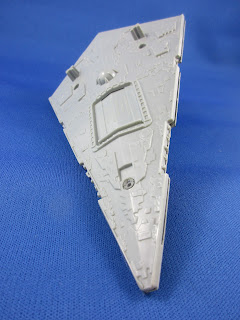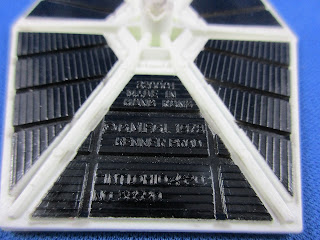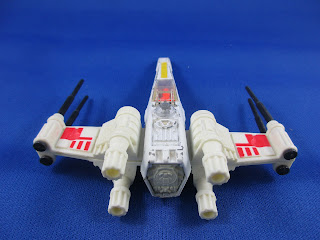The diecast line wound down to its conclusion with Series III, comprised entirely of vehicles from The Empire Strikes Back.
First up we have the Twin-Pod Cloud Car. Not sure exactly why this was chosen to be immortalized in the diecast range, as it barely appeared in the movie... but of course this was a mini-action-figure scale vehicle as well, so who knows...
Make sure that your loose Cloud Car has glass in the canopies!
It's relatively easy to find Cloud Cars in nice condition, as many were barely played with! The movable feature on the vehicle, of course, is the landing gear that manually extends and retracts from the fuselage.
Copyright info is on the underside of the central spar.
Slave I was also part of Series III. Unusually, there's no graphics or colour on the hull - just plain metal. You can just see Boba Fett in the cockpit in this shot.
There he is!
Action features on Slave I are the rotating wings and cannons.
Copyright info (as well as kind of an ugly scar) on hull bottom.
Lastly, here's the Snowspeeder, showing a bit of play wear. This seems typical for this ship and I think it demonstrates the love that kids showed them back in the day.
Like the X-Wing, the Snowspeeder features (two!) non-removable pilots, molded in orange plastic.
Harpoon launcher is present on the rear of the fuselage, but no harpoon or string, of course.
Cannons have gotten a bit warped over the years but the ship still looks good.
Copyright info on the wing bottom. Landing skid retracts into the fuselage.
So that's the diecast range - all three Series.A very fun and mostly economical run to collect (except for the TIE Bomber of course) and they look good on display too. If you're not into boxed or carded stuff they're even more appealing.
Anyway, I hope this tour through the world of vintage diecast has been amusing and informative!
A regularly updated blog about my vintage Kenner Star Wars toy collection. Some stuff that I've recently acquired; some stuff that I've had since I was a kid. Some rare, some common, but all sharing the warmth, charm and character of the "first generation" of Star Wars toys - the ones we played with as kids in the late '70s and early '80s.
Friday, August 23, 2019
Tuesday, August 6, 2019
Die Cast Series II
Four vehicles appeared in Series II of the diecast range: the Millennium Falcon, TIE Bomber, Imperial Cruiser/Star Destroyer, and Y-Wing. Let's get at 'em!
First up is the Falcon, another item from my childhood collection. A really cool little vehicle, although owning it didn't lessen my pain over never having the full-size Kenner version...
Super-detailed hull is made of diecast metal, with plastic parts (including lower hull) visible in this shot. Nice paintwork on the upper hull as well.
The radar dish and quad laser cannon are plastic and rotate freely.
Landing gear is retractable and even 40 years later, still stiffly sprung.
Here's the rarest of the bunch - the TIE Bomber. I won't go into a ton of detail on this one as you can read all about it here.
Just some slight yellowing on this example, but not nearly as bad as on others I've seen.
The "snowtrooper" pilot is somewhat visible in this shot. Unfortunately, unlike the other diecast TIE variants, the pilot is not removable. Not so bad I guess as it's one less thing for a child to lose.
Copyright info on the wings; both are identical.
Here's another from my childhood toy bin - the Imperial Cruiser. Obviously this was the "smallest scale" vehicle in a range where vehicles were rarely made in scale to one another.
Later renamed the "Star Destroyer" on its packaging, the toy was a combination of diecast metal and plastic - the upper hull being diecast.
The ship only starts to get really cool when you turn it over...
There we go. Sliding hatch showing 1979 copyright date opens to reveal the ventral docking bay...
...and a small but perfectly formed representation of Princess Leia's "consular ship", the Tantive IV or Blockade Runner.
Gotta be top 5 of all time in easily-lost ship parts!? Here's the Blockade Runner, only about the size of your fingernail and clinging to the docking bay by its dorsal fin. I'm sure that 3D printers the world over are cranking these out nowadays, but amazingly this one is original to my childhood toy.
Lastly in this review of Series II, we have the Y-Wing. Lots of plastic parts on this one, with diecast being limited to the main fuselage.
The detachable engine nacelles are plastic.
Underside view shows the retractable nose landing strut and pylons on the nacelles, as well as the red bomb.
Here's the ship in its component parts, showing the rotating guns and shiny droid dome. The latter is the bomb release - just push it down. Nacelles are a friction fit into the fuselage.
Copyright info. The bomb slips into the slot and is friction-gripped.
The little bomb! Also frequently lost, and now seen in the repro market, no diecast Y-Wing is complete without the little red bomb. Note also that the diecast bomb is one piece, unlike the two-piece bomb that comes with the full-size Kenner Y-Wing.
Stay tuned for Series III...
First up is the Falcon, another item from my childhood collection. A really cool little vehicle, although owning it didn't lessen my pain over never having the full-size Kenner version...
Super-detailed hull is made of diecast metal, with plastic parts (including lower hull) visible in this shot. Nice paintwork on the upper hull as well.
The radar dish and quad laser cannon are plastic and rotate freely.
Landing gear is retractable and even 40 years later, still stiffly sprung.
Copyright info on the bottom with a 1978 date.
Just some slight yellowing on this example, but not nearly as bad as on others I've seen.
The "snowtrooper" pilot is somewhat visible in this shot. Unfortunately, unlike the other diecast TIE variants, the pilot is not removable. Not so bad I guess as it's one less thing for a child to lose.
Copyright info on the wings; both are identical.
Here's another from my childhood toy bin - the Imperial Cruiser. Obviously this was the "smallest scale" vehicle in a range where vehicles were rarely made in scale to one another.
Later renamed the "Star Destroyer" on its packaging, the toy was a combination of diecast metal and plastic - the upper hull being diecast.
The ship only starts to get really cool when you turn it over...
There we go. Sliding hatch showing 1979 copyright date opens to reveal the ventral docking bay...
...and a small but perfectly formed representation of Princess Leia's "consular ship", the Tantive IV or Blockade Runner.
Gotta be top 5 of all time in easily-lost ship parts!? Here's the Blockade Runner, only about the size of your fingernail and clinging to the docking bay by its dorsal fin. I'm sure that 3D printers the world over are cranking these out nowadays, but amazingly this one is original to my childhood toy.
Lastly in this review of Series II, we have the Y-Wing. Lots of plastic parts on this one, with diecast being limited to the main fuselage.
The detachable engine nacelles are plastic.
Underside view shows the retractable nose landing strut and pylons on the nacelles, as well as the red bomb.
Here's the ship in its component parts, showing the rotating guns and shiny droid dome. The latter is the bomb release - just push it down. Nacelles are a friction fit into the fuselage.
Copyright info. The bomb slips into the slot and is friction-gripped.
The little bomb! Also frequently lost, and now seen in the repro market, no diecast Y-Wing is complete without the little red bomb. Note also that the diecast bomb is one piece, unlike the two-piece bomb that comes with the full-size Kenner Y-Wing.
Stay tuned for Series III...
Thursday, July 25, 2019
Walking Wind-Up R2-D2 (Kenner Canada/Takara)
Remember how I wrote a couple years back that my vintage run was complete? Well, I recently had second thoughts on that... of course, this has to do with the figure above - the infamous wind-up R2-D2 by Takara of Japan, sold briefly here by Kenner Canada.
The wind-up R2 is certainly familiar to collectors and was referenced as far back as 1992 in Steve Sansweet's seminal work, Star Wars: From Concept to Screen to Collectible. Sansweet wrote that the Takara R2 was one of George Lucas's favourite toys, and Lucasfilm ordered them by the thousand as gifts for employees and friends of the company. Lucasfilm pressured Kenner to license it or create their own wind-up R2, but Kenner demurred.
However, according to James McCallum in his book Irwin Toys: The Canadian Star Wars Connection, "Kenner Canada had a strong relationship with Takara of Japan" and "frequently took other products from them for Canada" in association with other toy lines. So it was with the wind-up R2. While in Japan it was sold loose, the figure was packaged for Canada on a bilingual blister card (known sometimes as an "18-back") that looked quite unlike any of the other Kenner cards. It retailed at Consumers Distributing (among other places) for $2.99.
The figure has two applied stickers front and back which are often missing. The name of the maker, Takara, is molded into the bottom of the chassis back, below the sticker. The front chrome details are actually quite impressively done, as shown in the first photo.
The COO "Japan" can be seen molded in block capitals underneath the manufacturer ID. The front bottom bit has an embossing of "(c) GMFGI. 1978".
R2's head rotates but doesn't click like the conventional action figure's. But of course, the real attraction of the figure is the wind-up walking action. Check it out in the video above!
Here's a group shot of the entire R2 range. L to R: Takara wind-up, standard R2, R2 Sensorscope, R2 with pop-up lightsaber. [edit: the ever-helpful Mike F. has pointed out that further R2s do exist, including the Droids, Lily Ledy, and Droid Factory three-legged variants. I have a DF R2 that didn't make it to picture day, but to me the Droids R2 is part of the Droids run and the Ledy R2 is a solid-dome variant :-)]
I'm really glad to have a nice example of this Japanese-Canadian figure in my collection, and the way I got him really illustrates the value of friends and community in tracking down rarer pieces like this. In this case, I got to meet some Ontario collectors when I was at Celebration in Chicago earlier this year, and it was in talking to my new buddy Mike F. that I realized that I needed - NEEDED - a wind-up R2 in my collection. Mike had actually brought TWO with him to Chicago but had already sold both, but when he acquired an entire loose run from another collector he suddenly found himself with a spare, which he kindly sold on to me. Cheers Mike!!
Mike also emphasized the importance (and rarity) of the figure being a good walker. Apparently the mechanisms wear out and are prone to damage from overwinding, so make sure to test before you buy. As you can see from the video, this one walks beautifully.
And with that the loose run REALLY IS COMPLETE. I mean it this time! :-)
The wind-up R2 is certainly familiar to collectors and was referenced as far back as 1992 in Steve Sansweet's seminal work, Star Wars: From Concept to Screen to Collectible. Sansweet wrote that the Takara R2 was one of George Lucas's favourite toys, and Lucasfilm ordered them by the thousand as gifts for employees and friends of the company. Lucasfilm pressured Kenner to license it or create their own wind-up R2, but Kenner demurred.
However, according to James McCallum in his book Irwin Toys: The Canadian Star Wars Connection, "Kenner Canada had a strong relationship with Takara of Japan" and "frequently took other products from them for Canada" in association with other toy lines. So it was with the wind-up R2. While in Japan it was sold loose, the figure was packaged for Canada on a bilingual blister card (known sometimes as an "18-back") that looked quite unlike any of the other Kenner cards. It retailed at Consumers Distributing (among other places) for $2.99.
The figure has two applied stickers front and back which are often missing. The name of the maker, Takara, is molded into the bottom of the chassis back, below the sticker. The front chrome details are actually quite impressively done, as shown in the first photo.
The COO "Japan" can be seen molded in block capitals underneath the manufacturer ID. The front bottom bit has an embossing of "(c) GMFGI. 1978".
Here's a group shot of the entire R2 range. L to R: Takara wind-up, standard R2, R2 Sensorscope, R2 with pop-up lightsaber. [edit: the ever-helpful Mike F. has pointed out that further R2s do exist, including the Droids, Lily Ledy, and Droid Factory three-legged variants. I have a DF R2 that didn't make it to picture day, but to me the Droids R2 is part of the Droids run and the Ledy R2 is a solid-dome variant :-)]
I'm really glad to have a nice example of this Japanese-Canadian figure in my collection, and the way I got him really illustrates the value of friends and community in tracking down rarer pieces like this. In this case, I got to meet some Ontario collectors when I was at Celebration in Chicago earlier this year, and it was in talking to my new buddy Mike F. that I realized that I needed - NEEDED - a wind-up R2 in my collection. Mike had actually brought TWO with him to Chicago but had already sold both, but when he acquired an entire loose run from another collector he suddenly found himself with a spare, which he kindly sold on to me. Cheers Mike!!
Mike also emphasized the importance (and rarity) of the figure being a good walker. Apparently the mechanisms wear out and are prone to damage from overwinding, so make sure to test before you buy. As you can see from the video, this one walks beautifully.
And with that the loose run REALLY IS COMPLETE. I mean it this time! :-)
Tuesday, July 23, 2019
Die Cast Series I
Kenner die-cast toys were released in three Series, or waves, starting in 1978 as shown on the cardback image above. And now, with the completion of my loose die-cast run, I can now post some comprehensive pics of the entire ill-starred Kenner series.
We'll start with Series I - let's dive right in!
This example is practically in pristine mint condition, and I think cost me $5. It was missing its windshield and this is commonly seen in die-cast 'speeders nowadays. Reproductions are available, but they don't come close to original quality - mine is a filler (marked "R" on one of the tabs) until I can find an original.
Bottom view shows the rolling wheels, though the toy wasn't suspended on springs like the larger Landspeeder. "1978" copyright date marks the Landspeeder as part of the first wave of die-cast vehicles.
Now this is more like it - the TIE Fighter. I got this one back in the late '70s and it is a bit of a sad story... living in Canada we have our share of very cold weather and we this can make plastic very brittle! Unfortunately for me I took my TIE Fighter to school one cold winter's day, and fell down with it in my pocket... and of course the wing snapped off...
Strangely enough the pilot included was none other than Darth Vader! The small Vader is a push-fit to the white plastic plug.
Both wings are identical, with copyright information inscribed on the inside of the wing surface.
Another one I had as a kid was this Darth Vader TIE Fighter, and just like the regular TIE Fighter, the wing connectors had broken, but worse yet I'd actually lost one of the wings!
The pilot capsule is the same as the regular TIE's, albeit in grey plastic to match the metal pod.
Copyright info on the inside of each wing - both are identical.
Finally in Series I we have the X-Wing Fighter, again a piece from my childhood collection. It's a miracle that it survived intact, really - especially that cockpit canopy.
Like the Landspeeder shown above, the X-Wing's canopy is frequently lost or broken. Even the way it connects to the ship fuselage is prone to breakage. The pilot figure in monochromatic orange plastic is not removable.
Fortunately the wing cannons are rubbery and firmly attached to the plastic wings.
The wings themselves extend and lock into the attack position. Unlike the larger X-Wing, you just pull the wings into position with your hands - the "Artoo head" on the fuselage is non-functional.
So that's Series I of the diecast series - big props go out to www.vintagestarwarsdiecast.co.uk for the cardback photo, and please visit them for more diecast content and history. Stay tuned for more on Series II and III!
Subscribe to:
Comments (Atom)



























































